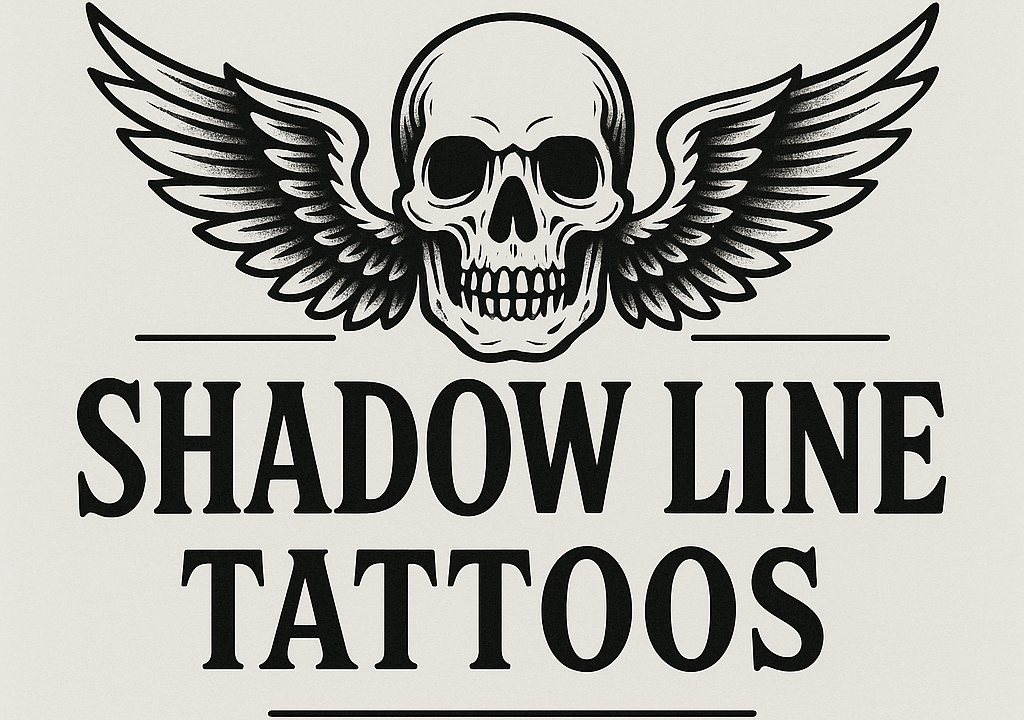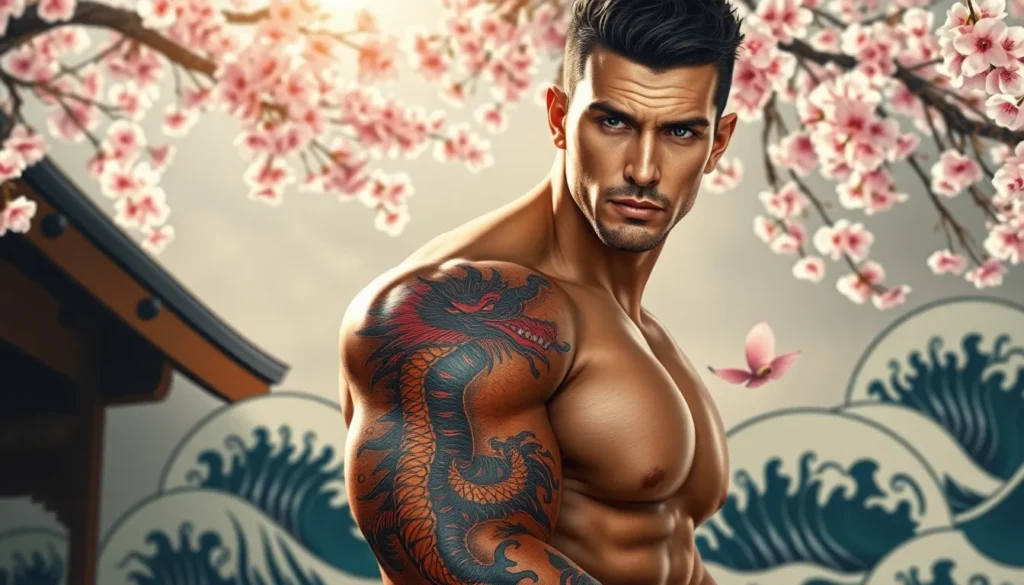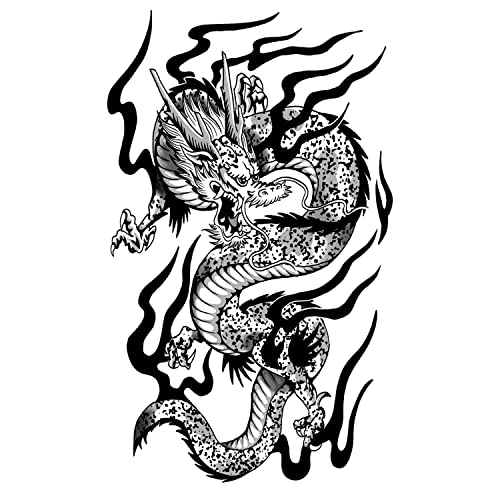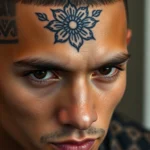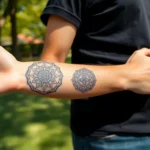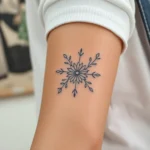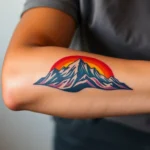Japanese tattoos have captured men’s attention worldwide with their bold imagery and deep cultural significance. We’ve seen countless guys transform their skin into powerful canvases featuring dragons that spiral across shoulders, koi fish swimming up forearms, and fierce samurai warriors standing guard on backs.
These aren’t just tattoos – they’re statements of strength and honor. Traditional Japanese tattoo art tells stories through intricate designs that blend mythology with personal meaning. From the protective power of oni masks to the wisdom represented by cherry blossoms, each element carries weight that goes far beyond aesthetics.
We’ll explore the most compelling Japanese tattoo concepts that resonate with modern men seeking artwork that commands respect. Whether you’re drawn to full sleeve masterpieces or prefer smaller symbolic pieces, Japanese tattooing offers endless possibilities to express your personality while honoring centuries-old artistic traditions.
Traditional Dragon Tattoo Designs for Masculine Appeal
Dragons represent the pinnacle of Japanese tattoo artistry, embodying power and wisdom that resonates deeply with men seeking meaningful body art. These majestic creatures transform skin into storytelling canvases that command respect and admiration.
Eastern Dragon vs. Western Dragon Symbolism
Eastern dragons carry profound spiritual significance that differs dramatically from their Western counterparts. Japanese dragons symbolize wisdom, strength, and good fortune rather than destruction and chaos. We see these serpentine beings as benevolent protectors who bring prosperity to those who honor them.
Western dragons typically appear as winged beasts associated with fire and aggression. Eastern dragons flow like water and wind, representing natural forces that nurture rather than destroy. These creatures often guard treasures of knowledge instead of hoarding gold, making them perfect symbols for men who value inner strength.
Traditional Japanese dragon tattoos feature long, snake-like bodies without wings, emphasizing their connection to water elements. Their fierce expressions convey protective energy while maintaining an air of ancient wisdom. Pearl clutching dragons represent the pursuit of enlightenment, while cloud-wrapped dragons symbolize spiritual ascension.
Popular Dragon Placement Options for Men
Back pieces offer the most dramatic canvas for full dragon compositions that showcase intricate scale work and flowing movement. These large-scale designs allow artists to capture every detail of the dragon’s magnificent form across the entire back surface. We recommend back placements for men who want maximum visual impact and storytelling space.
Sleeve tattoos create ever-changing movement as dragons wrap around arms in spiraling compositions. Half sleeves work perfectly for professional men who need coverage options, while full sleeves provide complete artistic freedom. The cylindrical shape of arms complements the serpentine nature of Japanese dragons naturally.
Chest pieces position dragons as protective guardians over the heart, symbolizing inner strength and courage. These placements often feature dragons emerging from waves or clouds, creating powerful focal points. Ribcage dragons follow the body’s natural curves while providing more discreet placement options.
Leg tattoos allow for vertical dragon compositions that can extend from thigh to ankle. These placements work exceptionally well for men who prefer larger tattoos in less visible areas. Dragons climbing up legs create impressive visual narratives about ascending power and determination.
Color Schemes That Enhance Dragon Tattoos
Traditional Japanese dragon colors carry exact meanings that enhance the tattoo’s symbolic power. Black and gray dragons emphasize strength and timelessness while maintaining classic aesthetic appeal. These monochromatic designs focus attention on linework and shading techniques that define traditional Japanese artistry.
Blue dragons represent wisdom and tranquility, connecting to water elements and peaceful strength. Green dragons symbolize nature and growth, perfect for men who value environmental consciousness and personal development. We often see these colors combined with subtle gold accents that highlight exact details.
Red dragons embody passion and protective energy, making them ideal for men with fierce personalities. Golden dragons represent prosperity and divine power, often reserved for the most spiritually important designs. These warm colors create striking contrasts against darker background elements.
Multi-colored dragons incorporate traditional Japanese color palettes that include deep blues, vibrant reds, and rich golds. These complex color schemes require skilled artists who understand traditional pigment relationships. Background elements like waves, clouds, and cherry blossoms often use complementary colors that enhance the dragon’s prominence without overwhelming the design.
Koi Fish Tattoos That Represent Strength and Perseverance
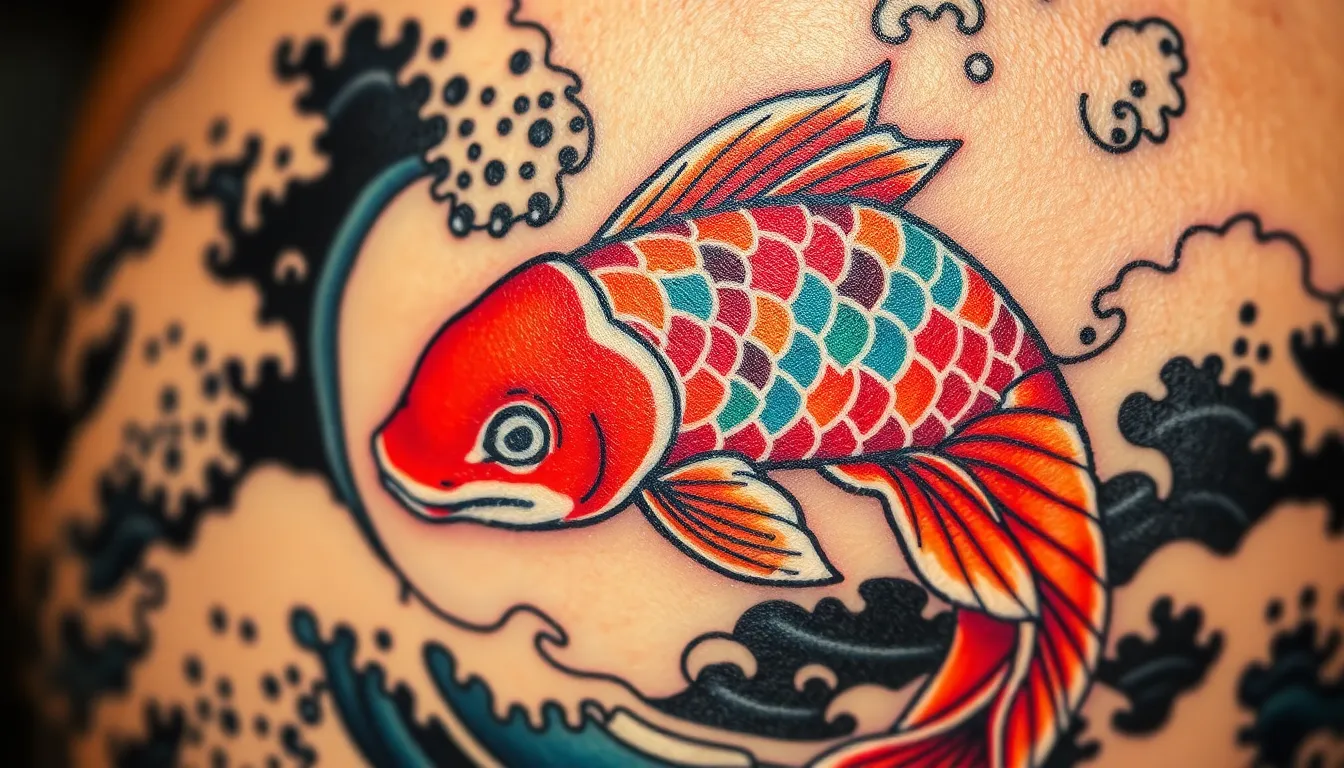
Japanese koi fish tattoos stand among the most meaningful designs for men seeking to express inner strength and determination. These powerful symbols connect directly to masculinity and courage while representing the ability to overcome life’s greatest challenges.
Upstream Swimming Koi Symbolism
Upstream swimming koi tattoos deliver one of the most powerful messages in Japanese body art. This design specifically represents fighting against obstacles and serves as a constant reminder never to give up when facing adversity. Men choose this particular orientation because it symbolizes determination and perseverance through difficult times. The upstream position marks personal triumph over challenges and demonstrates the strength needed to continue pushing forward against life’s currents.
Traditional placement for upstream koi often features the fish swimming vertically along the arm or leg, creating a natural flow that emphasizes the struggle against gravity and current. Artists frequently position these designs to follow the natural muscle lines, improving the sense of movement and power.
Black and Gray vs. Colorful Koi Designs
Black and gray koi tattoos focus primarily on contrast and texture to emphasize strength and resilience. These monochromatic designs highlight the fish’s natural form while drawing attention to the detailed scales and flowing fins. Men often prefer this approach for its timeless aesthetic and ability to age gracefully over decades.
Colorful koi designs showcase the vibrant symbolism embedded in traditional Japanese art. Red koi represent love and bravery, making them popular choices for men wanting to display courage. Black koi signify triumph over adversity, while gold variations symbolize wealth and good fortune. These color choices allow for personal customization based on individual life experiences and aspirations.
Design complexity varies significantly between the two approaches, with colorful versions requiring more sessions and skilled color theory application. Both styles maintain cultural authenticity while offering different visual impacts and personal expression opportunities.
Incorporating Water Elements and Waves
Water elements transform simple koi tattoos into ever-changing compositions that represent life’s constant changes. These flowing designs emphasize how personal actions create ripples that affect our surroundings. Artists typically incorporate traditional Japanese wave patterns that complement the koi’s natural swimming motion.
Wave integration adds movement and depth to the overall design while symbolizing the challenges we navigate daily. Traditional hokusai inspired waves create dramatic backdrops that enhance the koi’s journey through turbulent waters. These elements work together to tell stories of persistence through life’s storms.
Yin yang symbols frequently appear alongside water elements to represent harmony and balance within chaos. This combination creates meaningful tattoos that speak to finding peace amid life’s constant motion and change.
Samurai Warrior Tattoos for Honor and Courage
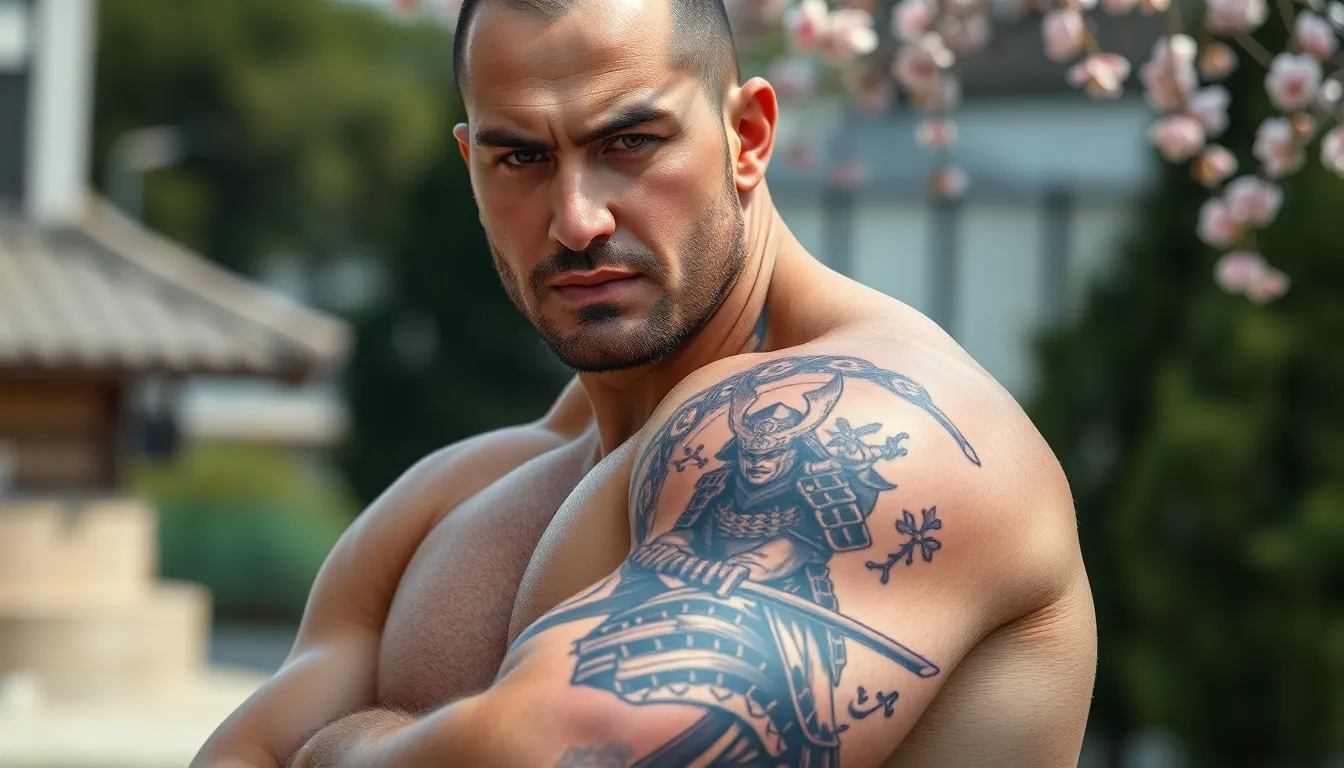
We find samurai warrior tattoos among the most sought-after Japanese designs for men, representing the pinnacle of honor, courage, discipline, and loyalty. These powerful symbols draw from Japan’s revered warrior class traditions and embody the Bushido code of ethics.
Full Samurai Portrait Designs
Full samurai portrait tattoos showcase warriors in breathtaking detail, capturing every element from intricate armor to intense facial expressions. Artists emphasize the katana as the central motif, representing both the warrior’s soul and the mental sharpness needed during adversity. These portraits symbolize resilience, nobility, and readiness to face life’s greatest challenges.
Detailed armor elements transform these tattoos into masterpieces, featuring authentic historical components that tell stories of ancient battles. Warriors appear in battle stance or meditative posture, serving as daily reminders of inner strength. Each portrait becomes a personal statement about upholding honor and embracing the warrior spirit in everyday life.
Samurai Mask and Helmet Tattoos
Samurai mask and helmet tattoos focus on the protective and mystical aspects of the warrior’s identity through kabuto helmets and men-yoroi masks. These designs emphasize strength, mystery, and battle readiness while showcasing incredible visual intricacy. Artists choose these elements for their representation of the samurai’s dual nature as both protector and figure of stoic resolve.
Kabuto helmet designs feature elaborate horn and crest details, creating striking focal points that command attention. Men-yoroi masks display fierce expressions meant to intimidate enemies while protecting the wearer’s identity. These tattoos appeal to men seeking symbolic armor that represents their own protective instincts and readiness for life’s battles.
Combining Samurai with Cherry Blossoms
Combining samurai tattoos with cherry blossoms adds profound cultural meaning rooted in Japanese philosophy about life’s fleeting nature. Cherry blossoms represent beauty, renewal, and impermanence, creating powerful contrasts when paired with warrior imagery. These designs feature warriors standing amidst falling cherry petals, symbolizing both strength and transient beauty.
Falling petal arrangements around samurai figures emphasize themes of sacrifice and duty while accepting life’s temporary nature. Artists position blossoms to frame the warrior or cascade around battle scenes, creating movement and emotional depth. These combinations appeal to men who understand that true strength includes embracing vulnerability and life’s precious moments.
Oni Demon Masks for Powerful Protection
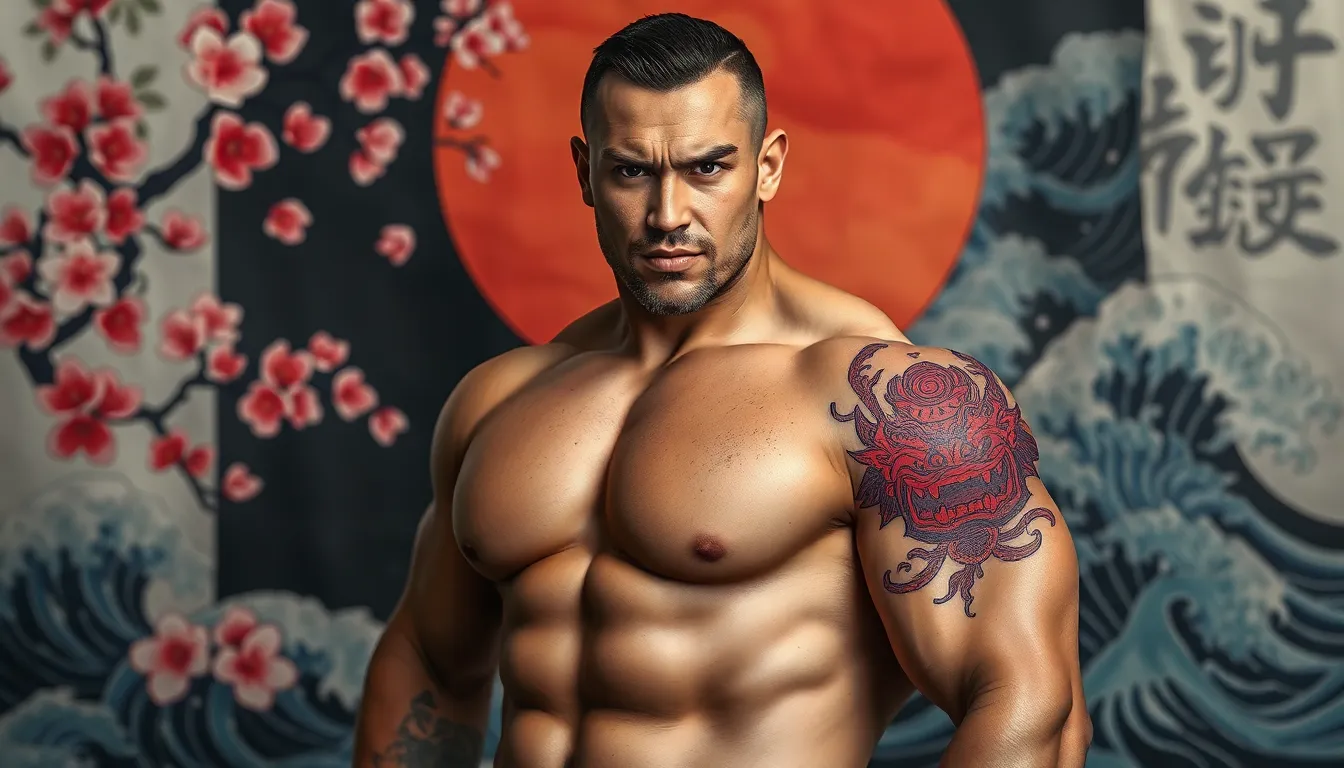
Japanese oni demon masks offer formidable protection symbolism that resonates deeply with men seeking spiritual guardianship through their body art. These fierce designs draw from centuries of Japanese folklore where oni spirits served as both harbingers of chaos and powerful protectors.
Red Oni vs. Blue Oni Meanings
Red oni tattoos embody fierce passion and overwhelming strength that appeals to men who channel their intensity through bold action. Traditional Japanese culture associates red oni with explosive energy and the warrior’s burning desire to overcome any obstacle. Men often choose red oni designs when they want to showcase their passionate nature and unwavering determination to protect what matters most.
Blue oni represents calmness and profound wisdom that contrasts beautifully with the demon’s intimidating appearance. These designs speak to men who value strategic thinking and controlled power over impulsive reactions. Blue oni tattoos symbolize the ability to remain composed under pressure while maintaining the strength to act decisively when circumstances demand it.
Both color variations offer distinct psychological benefits as protective talismans. Red oni serves as a reminder to embrace one’s inner fire while blue oni encourages thoughtful responses to life’s challenges.
Hannya Mask Variations for Men
Hannya mask tattoos depict the eternal struggle between good and evil that exists within every person’s soul. These designs originated from traditional Japanese theater where they represented jealous female spirits transformed by overwhelming emotion. Modern interpretations focus on the mask’s protective qualities rather than its gender-exact origins.
Men gravitate toward hannya masks because they symbolize the transformation of negative emotions into protective strength. The design’s fierce expression serves as a warning to enemies while reminding the wearer to control destructive impulses. Hannya tattoos work exceptionally well when combined with other Japanese elements like cherry blossoms or waves.
Contemporary artists often incorporate additional details like flames or geometric patterns to enhance the mask’s visual impact. These modifications allow men to personalize their hannya tattoos while maintaining the design’s traditional protective significance.
Sizing and Placement Considerations
Traditional placement follows the Japanese approach of covering larger body areas like the back, arms, or legs as part of comprehensive sleeve or full-body designs. These expansive canvases allow artists to capture every intricate detail of oni masks and surrounding elements. Back pieces provide the most space for complex oni compositions that include additional protective symbols.
Modern trends embrace placement flexibility with oni masks appearing on hands and necks for bold visibility. Shoulder placements work particularly well for men who want prominent protection symbols without committing to full sleeves. Chest pieces create powerful statements when oni masks are positioned over the heart area.
Size directly correlates with design complexity and the number of sessions required for completion. Larger oni tattoos demand more time investment but offer greater artistic detail and visual impact. Smaller versions focus on essential mask features while maintaining the design’s protective symbolism and cultural authenticity.
Cherry Blossom Tattoos That Balance Strength and Beauty
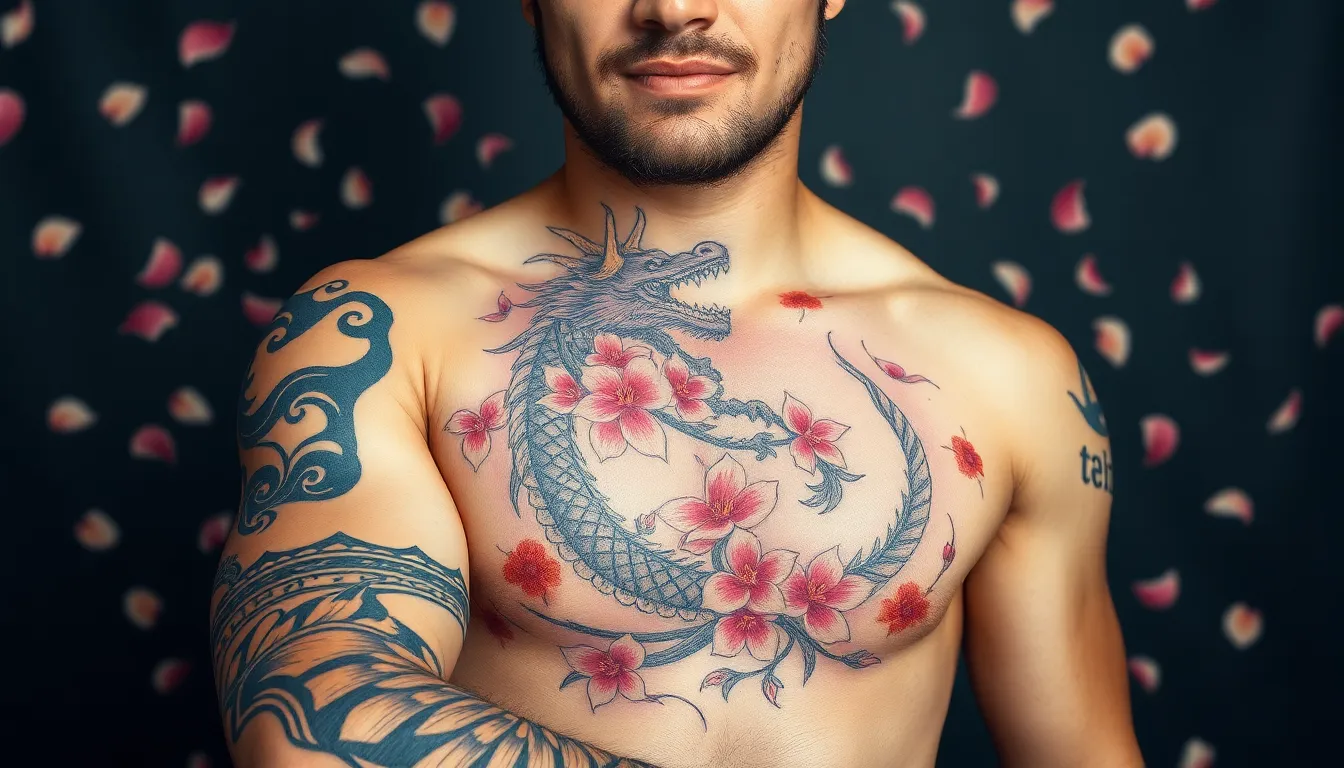
Cherry blossom tattoos offer men a unique opportunity to express both power and vulnerability through Japanese artistry. These designs challenge traditional masculine aesthetics by incorporating delicate beauty with bold symbolism.
Masculine Cherry Blossom Design Approaches
Bold line work transforms delicate sakura blossoms into powerful masculine statements. Artists achieve this balance by using thicker outlines and darker shading techniques that emphasize the structural elements of the flower. Adding prominent branches creates visual weight and stability, making the design feel grounded and strong.
Vibrant colors enhance the masculine appeal of cherry blossom tattoos through strategic color choices. Deep reds and rich pinks create intensity, while incorporating black backgrounds adds dramatic contrast. Leaves and bark textures provide additional masculine elements that complement the soft petals without overwhelming the design’s natural elegance.
Geometric patterns integrated with organic sakura shapes create contemporary masculine interpretations. These approaches combine traditional Japanese motifs with modern design elements, appealing to men who appreciate both heritage and innovation in their body art.
Combining Sakura with Other Japanese Elements
Dragons paired with cherry blossoms create compelling narratives about wisdom meeting transience. The dragon’s protective strength contrasts beautifully with the delicate sakura, representing how power and vulnerability coexist in life’s journey. This combination appeals to men seeking tattoos that reflect complex personal philosophies.
Koi fish swimming through falling cherry blossom petals symbolize perseverance through life’s fleeting moments. These designs often incorporate flowing water elements that carry both the fish and petals, creating ever-changing movement across the skin. The pairing reinforces themes of determination and acceptance of life’s temporary nature.
Tiger imagery combined with sakura branches represents the balance between ferocity and beauty. Traditional Japanese tigers positioned among cherry blossom trees create striking visual contrasts that embody both courage and appreciation for life’s delicate moments. Warriors and geishas integrated with cherry blossom backgrounds add cultural depth and storytelling elements to these masculine designs.
Seasonal Symbolism and Personal Meaning
Spring symbolism in cherry blossom tattoos resonates deeply with men experiencing life transitions or new beginnings. The fleeting nature of sakura blooms serves as a powerful reminder to embrace change and appreciate present moments. This seasonal connection makes cherry blossom tattoos meaningful choices for men marking important life events.
Personal meaning emerges from the impermanence themes that cherry blossoms represent in Japanese culture. Men often choose these designs to commemorate lost loved ones or acknowledge life’s fragility while celebrating its beauty. The tattoos become permanent reminders of temporary experiences that shaped their perspectives.
Cultural significance extends beyond aesthetic appeal, as cherry blossoms embody the Japanese concept of mono no aware—the bittersweet awareness of life’s transience. This philosophical depth attracts men who value tattoos with substance beyond visual impact, creating lasting connections between body art and personal growth.
Phoenix Tattoos Representing Rebirth and Resilience
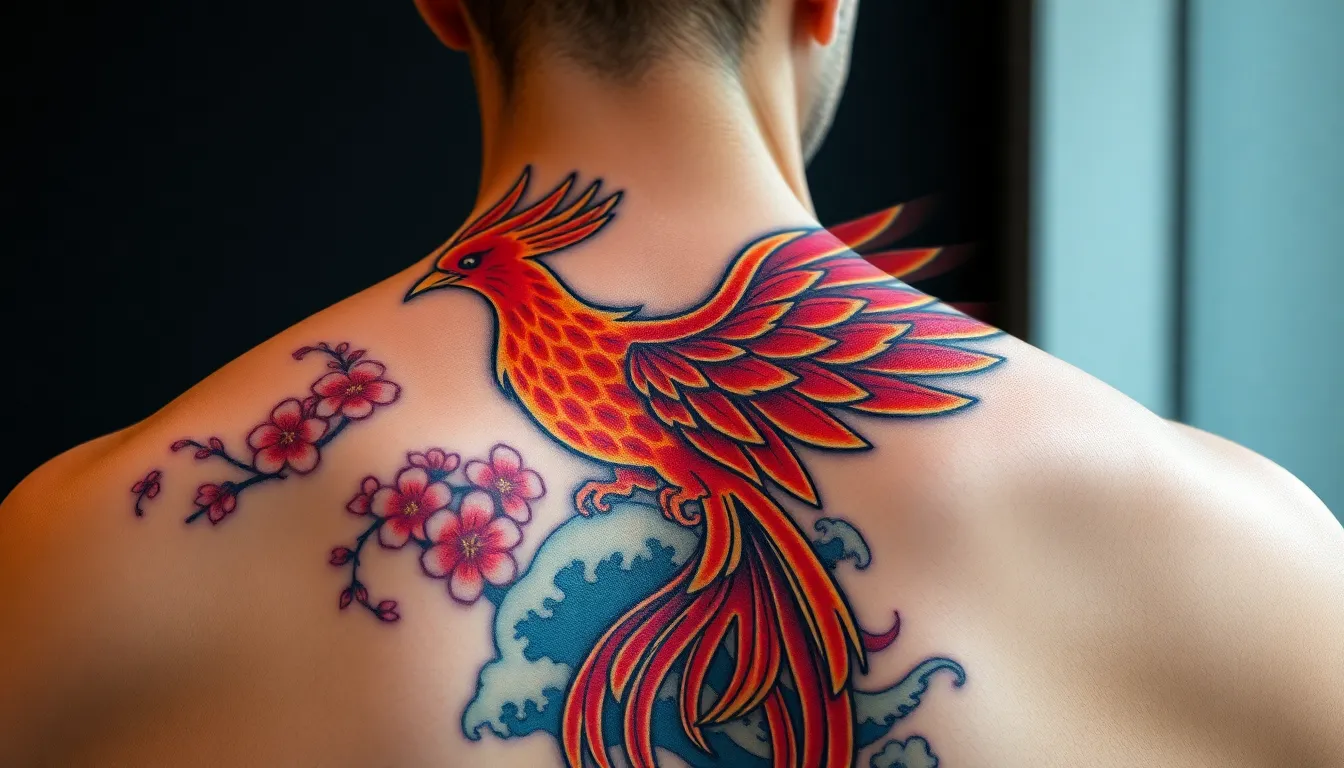
Phoenix tattoos hold profound meaning for men seeking to express their journey through adversity and triumph. The Japanese Hōō represents eternal life and the power to emerge stronger from life’s challenges.
Japanese Phoenix vs. Chinese Phoenix Styles
Japanese phoenix tattoos feature vibrant colors and distinctive avian-reptilian characteristics that emphasize strength and elegance. The Hōō displays dramatic wing patterns with bold red, orange, and gold hues that create visual impact across larger body areas.
Chinese phoenix designs contrast sharply with their Japanese counterparts through dragon-like features and harmonious color palettes. Feng Huang tattoos focus on balance and unity rather than the dramatic rebirth themes found in Japanese phoenix art. Artists often incorporate flowing lines and muted tones that represent peaceful transformation rather than fiery renewal.
Fire and Flame Integration Techniques
Fire elements amplify the symbolic power of phoenix tattoos through ever-changing color transitions and movement. Bright oranges, reds, and yellows create realistic flame effects that flow naturally around the phoenix’s body. Artists use gradient shading techniques to blend flames seamlessly with the bird’s feathers.
Subtle shadowing adds dimensional depth to flame patterns while maintaining the design’s overall balance. Strategic placement of fire elements can extend the tattoo’s visual impact beyond the phoenix itself. Contemporary artists experiment with flame shapes that incorporate geometric patterns for modern interpretations.
Full Back Phoenix Compositions
Full back phoenix designs offer unlimited creative possibilities through expansive canvas space and detailed customization options. The phoenix’s majestic form can span from shoulder to shoulder while incorporating traditional Japanese elements like cherry blossoms, waves, or clouds.
Vibrant flames often cascade down the spine or wrap around the torso to create ever-changing movement. Artists frequently combine multiple symbolic elements within these large scale compositions to tell personal stories of transformation. Background elements such as mountain landscapes or storm clouds enhance the phoenix’s emergence from adversity theme.
Color saturation becomes crucial in full back pieces where bold pigments ensure the design remains vivid over time. Layered composition techniques allow artists to create depth through overlapping elements that don’t compete with the central phoenix figure.
Tiger Tattoos Showcasing Power and Ferocity
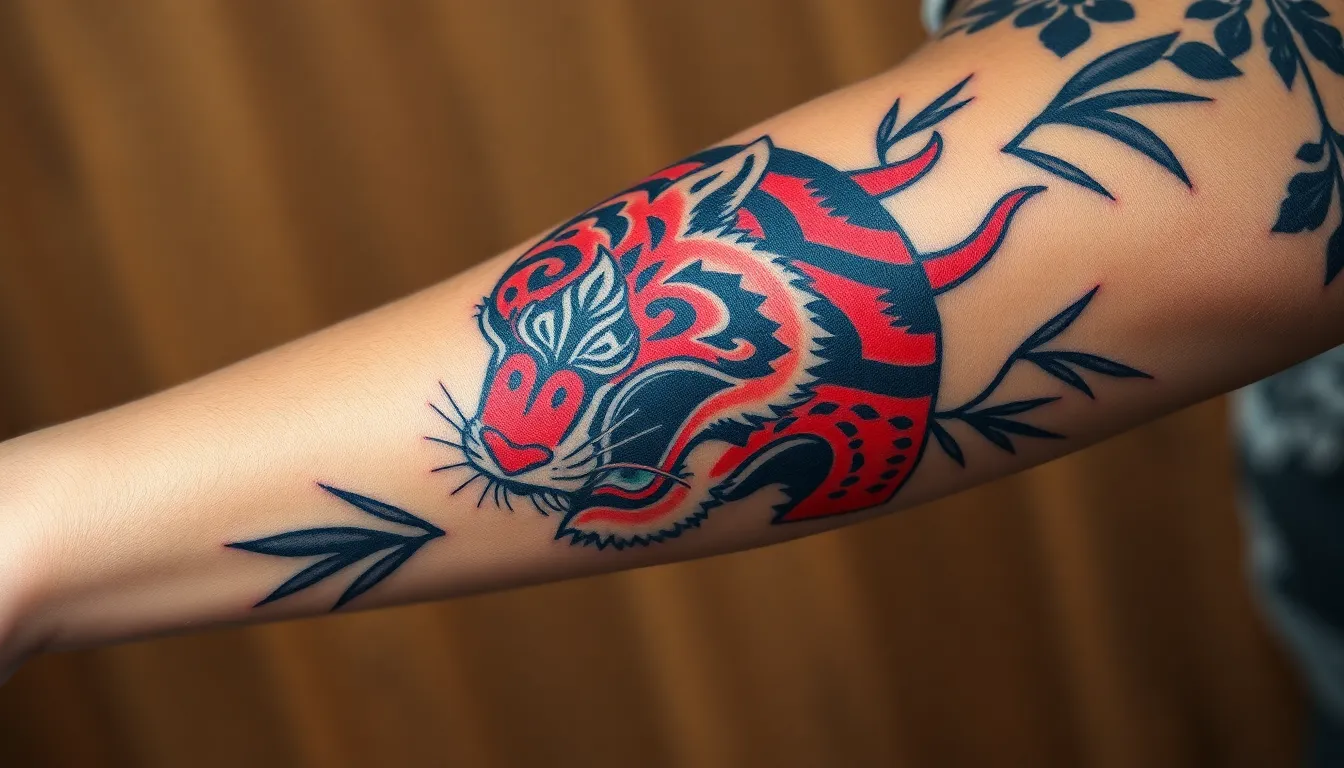
Japanese tiger tattoos represent raw strength and masculine energy, making them exceptional choices for men seeking powerful body art. These designs blend mythological significance with striking visual impact to create unforgettable tattoo statements.
Traditional Japanese Tiger Characteristics
Tigers hold profound meaning in Japanese folklore, symbolizing strength, courage, and protection against evil spirits and bad luck. These powerful creatures embody the warrior spirit that resonates deeply with men who value honor and resilience.
Traditional Japanese tiger designs feature intricate detailing that captures both mythic beauty and raw masculinity. Back pieces showcase the tiger’s full majestic form, while forearm placements allow for ever-changing muscle movement that enhances the design’s natural flow.
Artists often pair tigers with complementary motifs like cherry blossoms or dragons to create layered storytelling within the tattoo. Cherry blossoms add symbolic depth by contrasting the tiger’s power with life’s delicate nature, while dragon combinations amplify themes of strength and wisdom.
Tiger and Bamboo Combination Designs
Bamboo represents flexibility and resilience in Japanese culture, creating a perfect symbolic partnership with the tiger’s fierce nature. This combination balances strength with adaptability, appealing to men who navigate life’s challenges with both power and wisdom.
Design compositions featuring tigers and bamboo create visual harmony through contrasting textures and forms. Bamboo’s vertical lines complement the tiger’s muscular curves, while the natural movement in both elements suggests ever-changing energy and growth.
Placement options for tiger and bamboo designs work exceptionally well on the ribcage and upper arm areas. These locations allow the bamboo to follow natural body lines while giving the tiger adequate space for detailed rendering.
Bold Color Palettes for Maximum Impact
Traditional Japanese tiger tattoos use bold black lines and vibrant colors like red and blue to create maximum visual impact. Red enhances the tiger’s fierce energy and passion, while blue adds elements of wisdom and spiritual protection.
Modern interpretations incorporate neon colors or pastel shades for unique contemporary looks while maintaining the boldness associated with Japanese art. These color variations allow for personal expression without sacrificing the cultural significance of the design.
| Color | Traditional Meaning | Modern Application |
|---|---|---|
| Black | Strength and mystery | Bold outlines and shading |
| Red | Passion and courage | Tiger stripes and accents |
| Blue | Wisdom and protection | Background elements |
| Gold | Honor and prosperity | Highlighting and details |
Color saturation plays a crucial role in maintaining the tattoo’s vibrancy over time. Professional artists recommend deeper pigments for tiger designs to ensure the powerful imagery remains striking throughout the years.
Geisha Tattoos for Artistic and Cultural Appreciation
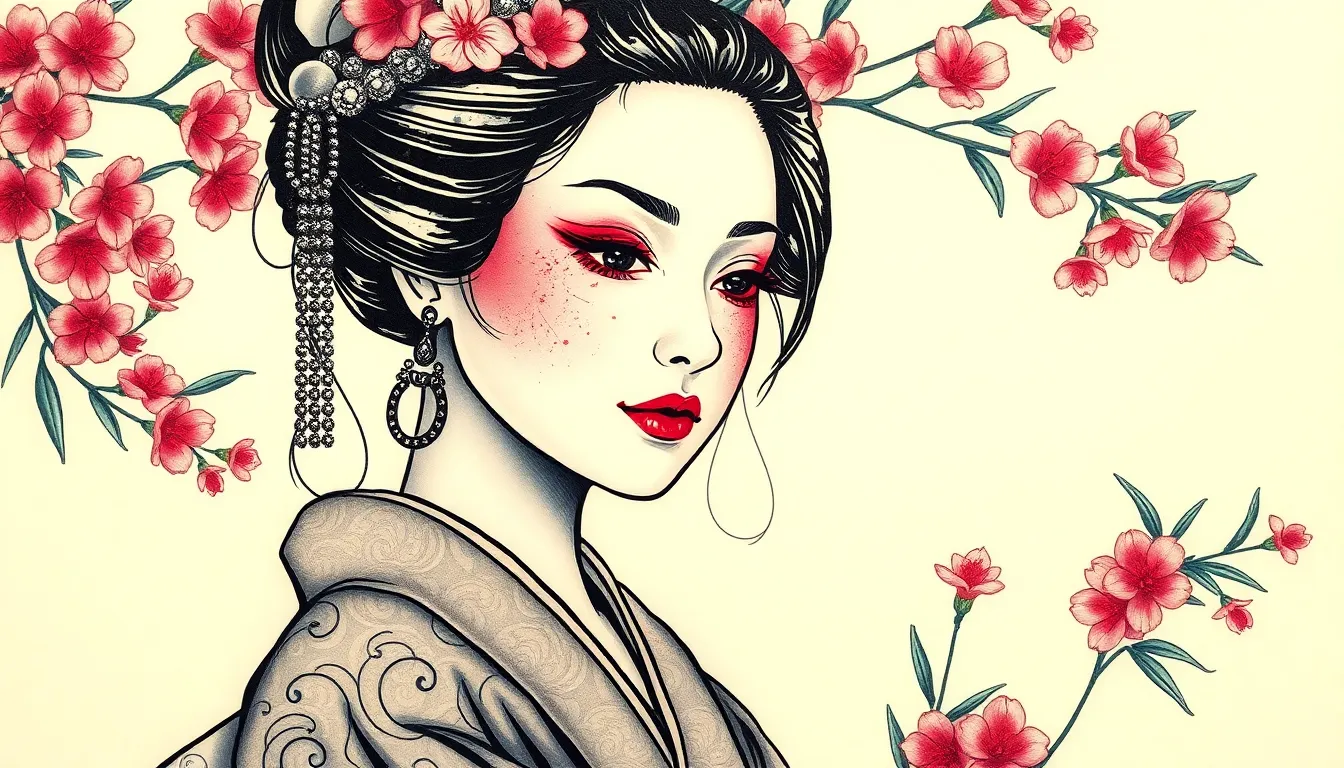
Geisha tattoos offer men an opportunity to showcase sophisticated artistry while honoring one of Japan’s most revered cultural traditions. These designs require careful consideration of cultural sensitivity and artistic excellence to create meaningful body art that celebrates rather than appropriates Japanese heritage.
Respectful Geisha Tattoo Approaches
Approaching geisha tattoos with proper respect begins with understanding their cultural significance beyond mere aesthetic appeal. We recommend working with artists who specialize in Japanese traditional tattooing and possess deep knowledge of geisha culture, ensuring your design honors the artistry and dedication these women represent.
Researching the historical context of geishas helps create tattoos that celebrate their role as skilled entertainers, musicians, and conversationalists rather than perpetuating Western misconceptions. Consulting with Japanese cultural experts or tattoo artists with authentic training in irezumi techniques adds layers of authenticity to your design process.
Avoiding sexualized interpretations preserves the dignity of geisha culture while focusing on elements like graceful poses, traditional instruments, or ceremonial activities. We suggest incorporating symbolic elements that reflect the geisha’s artistic mastery, such as shamisen instruments, tea ceremony tools, or dance fans, which emphasize skill over superficial beauty.
Traditional Clothing and Accessory Details
Traditional kimono patterns provide endless opportunities for intricate tattoo detailing that showcases Japanese textile artistry. We often see stunning designs featuring elaborate obi sashes with geometric patterns, floral motifs, or seasonal symbols that tell stories through fabric representation.
Hair ornaments called kanzashi offer delicate focal points that demonstrate the wearer’s status and the season being celebrated. Popular kanzashi designs include cherry blossom pins for spring, maple leaf ornaments for autumn, and elaborate golden combs for formal occasions, each requiring precise linework to capture their intricate beauty.
Makeup details like the distinctive white face powder, red lip color, and decorative eyebrow styling create striking visual contrasts in tattoo form. We recommend focusing on the artistic precision of geisha makeup application, particularly the subtle gradations where white makeup meets natural skin tone at the neckline.
Fan positioning and hand gestures carry exact meanings in geisha culture, making them excellent elements for tattoo storytelling. Closed fans suggest mystery and anticipation, while open fans display the artistry of painted designs featuring landscapes, poetry, or seasonal flowers.
Black and Gray Realism vs. Traditional Style
Black and gray geisha tattoos excel at capturing subtle emotional expressions and the delicate interplay of light and shadow across traditional makeup. We find this style particularly effective for emphasizing the contemplative nature of geisha culture, using detailed shading techniques to create depth in fabric folds and facial features.
Realistic approaches allow for incredible detail in textile patterns, hair textures, and the subtle gradations of traditional white makeup application. Artists specializing in photorealistic techniques can capture the intricate embroidery patterns found on authentic kimonos, creating tattoos that serve as wearable art galleries.
Traditional Japanese color palettes bring vibrancy and cultural authenticity to geisha tattoos through bold reds, deep blues, and gold accents. We see stunning results when artists use traditional irezumi color combinations, such as red kimono fabric contrasted against black hair ornaments and white makeup.
Vibrant traditional styles often incorporate background elements like cherry blossoms, bamboo, or traditional architecture that provide context for the geisha figure. These colorful compositions create ever-changing storytelling opportunities while maintaining the bold visual impact characteristic of Japanese traditional tattooing.
Hybrid approaches combine realistic portrait techniques with traditional Japanese background elements, allowing for personalized interpretations that respect cultural boundaries. We recommend discussing with your artist how to balance photorealistic geisha portraits with stylized traditional elements like swirling clouds, geometric patterns, or seasonal flowers that enhance rather than compete with the central figure.
Wave and Water Tattoos Inspired by Hokusai

Hokusai’s masterful wave artistry transforms masculine body art through powerful water motifs that embody resilience and strength. Men choose these designs to represent their ability to navigate life’s turbulent moments with grace and determination.
Great Wave Design Adaptations
Minimalist wave tattoos capture Hokusai’s essence through clean black linework and strategic highlighting that creates natural movement across the skin. Artists adapt the iconic Great Wave Off Kanagawa design by simplifying complex details while maintaining the dramatic impact of crashing water. Contemporary interpretations often incorporate geometric elements that enhance the wave’s natural flow patterns.
Traditional wave symbolism resonates deeply with men seeking tattoos that represent the duality of destruction and creation in their personal journeys. These designs symbolize the resilience and strength needed to face life’s challenges, making them meaningful choices for those who’ve overcome important obstacles. Color variations range from classic black and gray to subtle blue tones that capture water’s natural essence.
Incorporating Koi Fish with Waves
Koi fish swimming upstream through crashing waves creates powerful narratives about perseverance and courage in tattoo designs. The combination enhances the symbolism of overcoming challenges, as koi fish represent good luck and determination while waves embody life’s obstacles. Artists often position the fish at ever-changing angles to show their struggle against the water’s force.
Vibrant color combinations bring these designs to life through bold oranges, deep reds, and golden yellows that contrast beautifully with blue and white wave patterns. Traditional Japanese color schemes emphasize the interaction between the living creature and its environment. Design variations can feature multiple koi or single fish compositions depending on the wearer’s personal story and available space.
Sleeve and Wrap-Around Wave Concepts
Full sleeve wave designs create cohesive visual stories that flow naturally around the arm’s contours while incorporating multiple Japanese elements. These comprehensive pieces often weave together waves, cherry blossoms, and traditional clouds to establish complete artistic narratives. Artists use the arm’s natural muscle definition to enhance the wave’s three dimensional appearance.
Wrap around leg designs provide extensive canvas space for intricate wave details and symbolic elements that tell complex personal stories. The continuous flow around the limb allows waves to appear as though they’re literally wrapping the body in protective water energy. These designs work particularly well for men who want their tattoos to follow natural body lines while maintaining traditional Japanese aesthetic principles.
Japanese Sleeve Tattoo Combinations and Themes
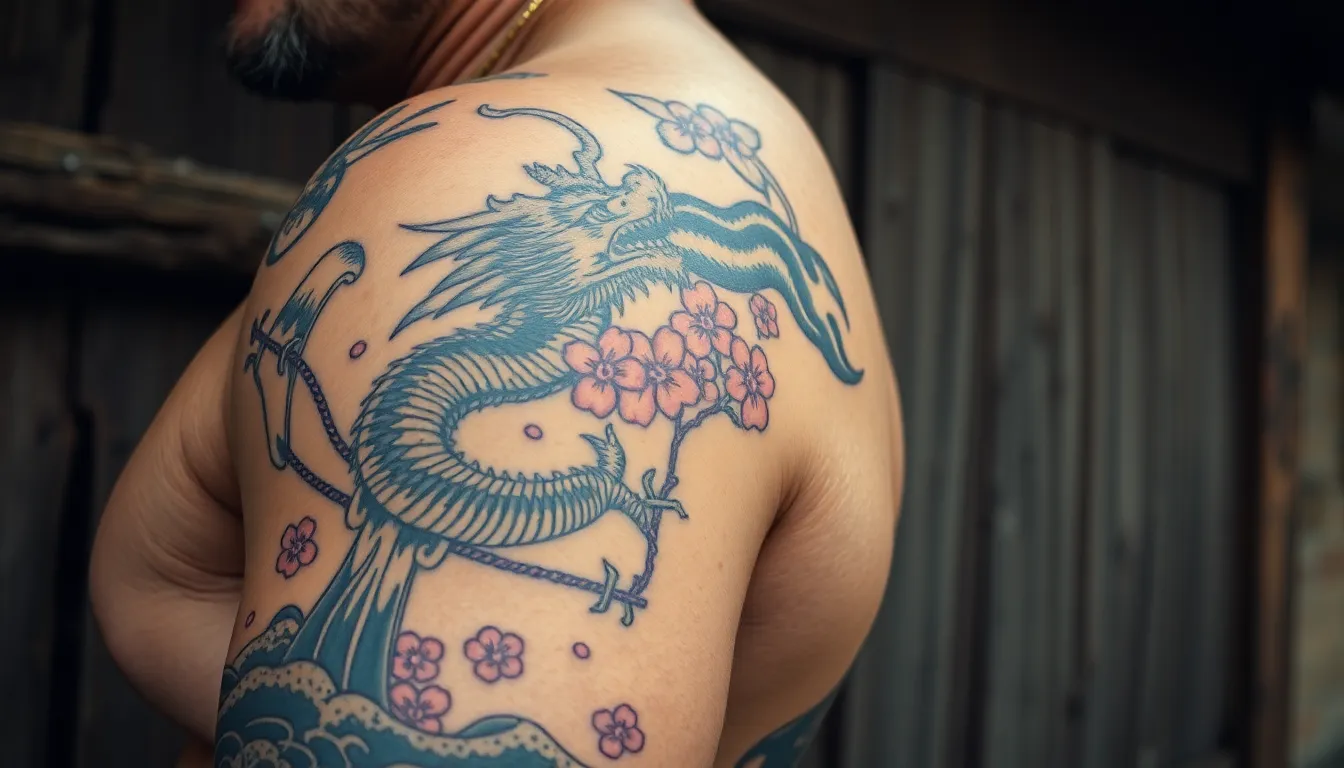
Japanese sleeve tattoos offer men the ultimate canvas for storytelling through intricate cultural symbols and artistic mastery. We’ll explore the structural foundations and creative possibilities that make these designs uniquely compelling.
Traditional Irezumi Sleeve Structure
Full Sleeve (Nagasode) designs extend from the chest over the shoulder and down the arm, creating the most comprehensive canvas for Japanese tattoo artistry. This traditional approach allows artists to incorporate multiple elements while maintaining visual harmony throughout the entire composition.
Shichibusode represents the seven-tenths sleeve that stops below the elbow, offering substantial coverage while preserving some flexibility for professional environments. Men who choose this style often appreciate the balance between bold artistic expression and practical considerations.
Gobusode encompasses the five-tenths sleeve that ends above the elbow, providing a focused area for concentrated design elements. This shorter variation works exceptionally well for showcasing single dominant motifs like dragons or koi fish with supporting elements.
Kubu and Tobu variations offer precise ending points that enhance the overall aesthetic flow. The Kubu ends at the wrist bone while the Tobu finishes just above the hands, creating clean boundaries that respect traditional Japanese tattooing principles.
Mixing Multiple Elements Effectively
Dragons paired with cherry blossoms create powerful contrasts between strength and transience, representing the complexity of masculine identity. We often see artists incorporate flowing water elements to connect these disparate symbols into cohesive narratives.
Koi fish swimming through waves alongside traditional clouds can represent perseverance through life’s challenges. These combinations work particularly well when the koi appears to be moving upward against the current, symbolizing determination and courage.
Oni demons positioned with protective elements like temple guardians or sacred flames create ever-changing tension within sleeve compositions. Artists frequently use these mythological figures to anchor larger designs while maintaining cultural authenticity.
Natural elements including bamboo, mountains, and seasonal flowers provide backgrounds that enhance primary motifs without overwhelming them. We recommend balancing bold central figures with subtle environmental details to create depth and visual interest.
Planning Your Japanese Tattoo Journey
Research cultural significance thoroughly before committing to exact symbols, as Japanese tattoos carry deep meanings that extend beyond aesthetic appeal. We suggest consulting with artists who specialize in traditional irezumi techniques and understand the historical context of these designs.
Use 3D virtual try-on tools to visualize how sleeve designs will flow around your arm’s natural contours. These technologies help you understand how different elements will interact when wrapped around cylindrical surfaces.
Consider the stigma associated with tattoos in Japanese culture, particularly if you plan to visit Japan or work with Japanese companies. Understanding this cultural context helps you make informed decisions about placement and visibility.
Budget for quality artistry as authentic Japanese sleeve tattoos require important time investment and skilled craftsmanship. We typically see these projects taking 20-40 hours of work spread across multiple sessions to achieve the level of detail these designs deserve.
Conclusion
Japanese tattoo art offers men an extraordinary opportunity to express their personal journeys through centuries-old symbolism and masterful craftsmanship. Whether you’re drawn to the protective power of dragons the resilience of koi fish or the honor of samurai warriors these designs provide meaningful ways to showcase your values and experiences.
The beauty of Japanese tattooing lies in its ability to combine bold masculine aesthetics with deep cultural significance. From full sleeve compositions to smaller symbolic pieces each design tells a unique story that resonates with modern men seeking authentic self-expression.
Remember that these tattoos represent more than just visual appeal – they’re investments in artistry that’ll grow with you throughout your life. Take time to research experienced artists who understand traditional techniques and cultural meanings to ensure your tattoo honors both the art form and your personal story.
Frequently Asked Questions
What makes Japanese tattoos so popular among men?
Japanese tattoos combine bold imagery with rich cultural significance, serving as powerful statements of strength and honor. They’re not merely decorative but tell meaningful stories through intricate designs incorporating mythology and personal symbolism. Their appeal lies in the balance between traditional artistry and modern masculine aesthetics.
What do dragon tattoos symbolize in Japanese culture?
Japanese dragons represent benevolence, wisdom, power, and good fortune, contrasting with Western dragons associated with destruction. They embody positive qualities and are often chosen by men seeking meaningful body art that reflects strength and wisdom. Different colors carry specific meanings – black for mystery, blue for tranquility, and red for passion.
Why are koi fish tattoos significant for men?
Koi fish tattoos symbolize strength, perseverance, and inner courage. Upstream swimming koi particularly represent overcoming obstacles and persistence through adversity. They appeal to men who want to express resilience and determination, often incorporating water elements that symbolize life’s changes and personal transformation.
What do samurai warrior tattoos represent?
Samurai tattoos embody honor, courage, discipline, and loyalty – core masculine virtues. They often feature katanas symbolizing resilience and nobility, masks representing protection, and combinations with cherry blossoms that contrast strength with life’s transient nature. These designs appeal to men who value warrior principles and traditional honor codes.
Are cherry blossom tattoos appropriate for men?
Yes, cherry blossom tattoos offer men a unique way to express both power and vulnerability. Bold line work, vibrant colors, and geometric patterns enhance their masculine appeal. They symbolize life’s beauty and transience, often chosen to commemorate transitions, new beginnings, or honor loved ones while challenging traditional masculine aesthetics.
What’s the cultural significance of oni demon masks?
Oni demon masks symbolize formidable protection and spiritual guardianship. Red oni represent fierce passion and strength, while blue oni embody calmness and wisdom. Both serve as protective talismans, helping men channel different psychological responses to challenges while honoring Japanese folklore traditions.
How do phoenix tattoos appeal to men?
Phoenix tattoos symbolize rebirth and resilience, perfect for men expressing their journeys through adversity. Japanese Hōō designs feature vibrant colors and dramatic wing patterns, while fire elements enhance rebirth symbolism. They represent transformation, renewal, and the ability to rise stronger from challenges.
What should I consider when planning a Japanese sleeve tattoo?
Consider traditional sleeve structures like Nagasode (full sleeve), Shichibusode (seven-tenths), or Gobusode (five-tenths). Plan cohesive narratives by mixing elements thoughtfully – dragons with cherry blossoms or koi with waves. Research cultural significance, budget for quality artistry, and work with artists experienced in traditional Japanese tattooing.
How important is cultural authenticity in Japanese tattoos?
Cultural authenticity is crucial for respecting Japanese traditions and ensuring meaningful designs. Research the cultural significance of chosen elements, work with knowledgeable artists, and avoid appropriation by understanding the deeper meanings. Authentic designs maintain protective symbolism and honor the rich heritage behind each traditional motif.
What are the best placement options for Japanese tattoos?
Traditional placements include full back pieces for large designs like dragons or phoenixes, sleeves for storytelling narratives, and chest or ribcage for powerful motifs. Modern trends favor bold visibility on hands and necks. Consider the relationship between size, design complexity, and the time investment required for completion.
